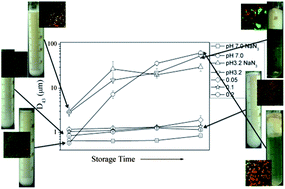Stability and antimicrobial property of soy protein/chitosan mixed emulsion at acidic condition
Abstract
To fabricate a soy protein emulsion with good storage stability against microorganisms, we investigated the stability and antimicrobial activity of a β-conglycinin (7S) and chitosan (CS) mixed emulsion at acidic pHs. Results of droplet size and microstructure showed that 7S/CS mixed emulsions were stable at acidic pHs while the 7S emulsion was not. As for the storage test, results showed that the 7S/CS mixed emulsion displayed an significantly (p < 0.05) improved storage stability than the control both under un-inoculated and inoculated conditions at 20 °C because of the presence of chitosan. A well diffusion assay showed that the 7S/CS mixed emulsion provided better inhibition against Escherichia coli and the minimum mixing ratio of the chitosan content, of 0.25 mg mL−1, adequately inhibited the bacteria used in this research. Moreover, the aerobic plate count analysis indicated that the 7S/CS mixed emulsion, compared to the control, effectively inhibited the growth of microorganisms. This inhibition was believed to be independent of the CS/7S mixing ratio. The results in this paper demonstrate that the growth of microorganisms dramatically accelerated the destabilization of the stable 7S emulsion and the fabrication of 7S/CS mixed emulsion could increase the acidic stability and antimicrobial activity in order to extend shelf-life.


 Please wait while we load your content...
Please wait while we load your content...